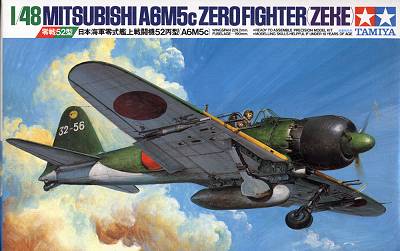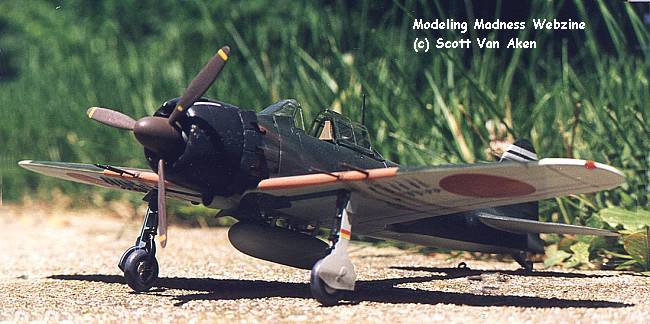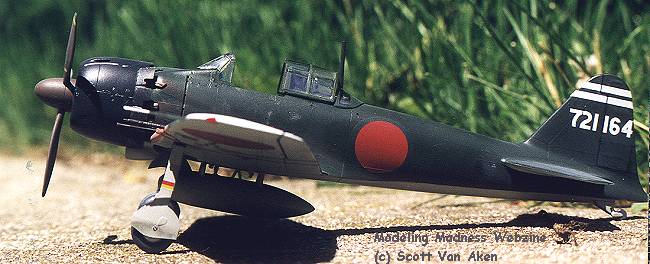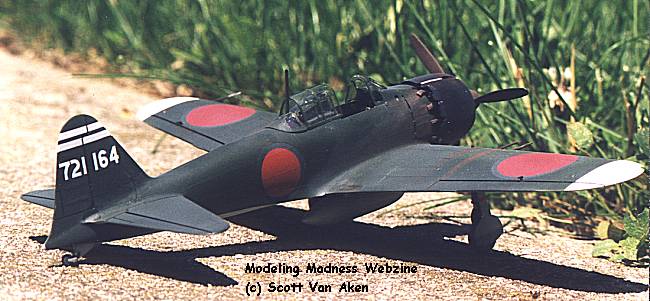
Kit: Tamiya 1/48 A6M5c Zero

Kit Number: 61027
Price: 1000 yen plus shipping
Media: Injected Plastic
Decals: Seven versions, all in IJN Green upper and IJN grey lower with yellow wing ID stripes
Date of Review: 3 June 1998
Review and Photos by: Scott Van Aken

Mitsubishi's A6M5 series was the most produced of the famous Zero, with Mitsubishi turning out about 4,000 and another 6,500 built by Nakajima. Differences in this Zero and the preceding ones are a more powerful Sakae engine, a different wing planform that was broader and shorter in span, self-sealing fuel tanks and greater armament comprising 1 13mm gun in the cowling, and 1 13mm and 1 20mm gun in each wing. The A6M5c was also capable of carrying light bombs and rockets.
Tamiya's kit of the Zero (probably the most kitted aircraft in the world), was released in 1983, when Tamiya was concentrating on armor kits. Very much a state of the art kit 15 years ago, only the more recently released series by Hasegawa supercedes it. Molded in dark green plastic there is a combination of raised and recessed panel lines. The cockpit is quite complete with great detail on the fuselage sides and the rest of the cockpit. The instruments are provided by decals and are quit convincing once applied. I painted the interior with Aeromaster's Mitsubishi interior green in the hopes that I was modelling one of the Mitsubishi built aircraft. Once dry, details were picked out in black and white and the interior then washed with black and drybrushed in steel.
Fit of the kit is really quite good, nearly as good as current Tamiya kits. The areas where I needed filler were the rear of the wing/fuselage join and the area in front of the cockpit. For some reason, this did not fit well at all, though in fairness, it could have been my fault. It caused trouble later when fitting the windscreen. Tamiya gives you the option of an open or closed canopy. I chose open and must warn builders that in this guise, it cannot be easily displayed closed as the main canopy does not fit well in the closed position.

The engine is more simple than today's kits and does not have engine push-rods although the instructions tell you how to make them (all 28 of them). Once assembled and washed, the engine looks realistic enough. The ejector exhaust attaches to the engine mount and was painted burnt iron. I left off the engine and cowling until after the kit was completed.
The kit comes with options for raised or lowered landing gear so there is no need to have to cut the gear doors as is now common practice. The instructions show how to add brake lines if you so desire. The gear fit with no problem, the wells and gear door interiors were painted Aotake Blue from Xtracolor. You also get optional underwing stores of rockets or bombs, but I left them off my Zero.
The main reason I wanted to build this version was to use some decals from the Aeromaster Kamikaze sheet. The A6M5 I chose was from the 721 Naval Air Group, whose Zeros had white upper wing tips. This aircraft also has the white Hinomaru surround painted out in green, and these insignia are supplied with the sheet. They went on a beautifully as any Aeromaster decal and responded well to decal setting solution. What is not provided are the other standard markings and I had to use kit decals for these. These decals react badly to setting solutions so none was used. Final coat was a semi-matte finish and then the masking was removed from the wheel wells and canopy. The kit was then given a brush of pastels in the exhaust and gun areas.
Overall, this is a fine representation of the late model Zero, and despite its age and the fact that it has been through several thousand cycles, the molds are in great shape. Highly recommended.
